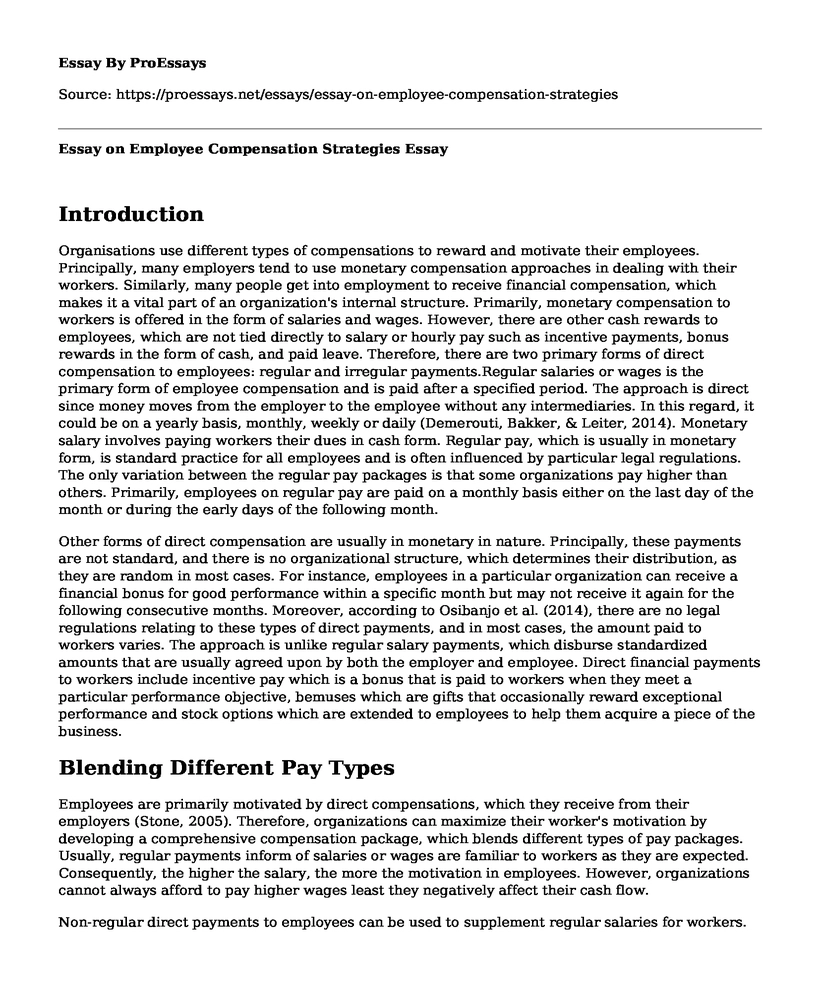Introduction
Organisations use different types of compensations to reward and motivate their employees. Principally, many employers tend to use monetary compensation approaches in dealing with their workers. Similarly, many people get into employment to receive financial compensation, which makes it a vital part of an organization's internal structure. Primarily, monetary compensation to workers is offered in the form of salaries and wages. However, there are other cash rewards to employees, which are not tied directly to salary or hourly pay such as incentive payments, bonus rewards in the form of cash, and paid leave. Therefore, there are two primary forms of direct compensation to employees: regular and irregular payments.Regular salaries or wages is the primary form of employee compensation and is paid after a specified period. The approach is direct since money moves from the employer to the employee without any intermediaries. In this regard, it could be on a yearly basis, monthly, weekly or daily (Demerouti, Bakker, & Leiter, 2014). Monetary salary involves paying workers their dues in cash form. Regular pay, which is usually in monetary form, is standard practice for all employees and is often influenced by particular legal regulations. The only variation between the regular pay packages is that some organizations pay higher than others. Primarily, employees on regular pay are paid on a monthly basis either on the last day of the month or during the early days of the following month.
Other forms of direct compensation are usually in monetary in nature. Principally, these payments are not standard, and there is no organizational structure, which determines their distribution, as they are random in most cases. For instance, employees in a particular organization can receive a financial bonus for good performance within a specific month but may not receive it again for the following consecutive months. Moreover, according to Osibanjo et al. (2014), there are no legal regulations relating to these types of direct payments, and in most cases, the amount paid to workers varies. The approach is unlike regular salary payments, which disburse standardized amounts that are usually agreed upon by both the employer and employee. Direct financial payments to workers include incentive pay which is a bonus that is paid to workers when they meet a particular performance objective, bemuses which are gifts that occasionally reward exceptional performance and stock options which are extended to employees to help them acquire a piece of the business.
Blending Different Pay Types
Employees are primarily motivated by direct compensations, which they receive from their employers (Stone, 2005). Therefore, organizations can maximize their worker's motivation by developing a comprehensive compensation package, which blends different types of pay packages. Usually, regular payments inform of salaries or wages are familiar to workers as they are expected. Consequently, the higher the salary, the more the motivation in employees. However, organizations cannot always afford to pay higher wages least they negatively affect their cash flow.
Non-regular direct payments to employees can be used to supplement regular salaries for workers. In this regard, an organization can have a performance-based reward system where employees are rewarded with direct monetary incentives on a monthly basis. In this regard, most workers will be motivated to work hard and achieve exceptional standards with the hope of getting the rewards. Additionally, organizations can have a bonus distribution system in which employees receive direct bonuses if the organization performs well. Consequently, workers will be motivated to offer better service for the good of the organization so that they can benefit from the bonuses.
References
Demerouti, E., Bakker, A. B., & Leiter, M. (2014). Burnout and job performance: The moderating role of selection, optimization, and compensation strategies. Journal of occupational health psychology, 19(1), 96.
Osibanjo, A. O., Adeniji, A. A., Falola, H. O., & Heirsmac, P. T. (2014). Compensation packages: a strategic tool for employees' performance and retention. Leonardo Journal of Sciences, (25), 65-84.
Stone, R. J. (2005). Human resource management. Milton, Old: John Wiley & Sons Australia.
Cite this page
Essay on Employee Compensation Strategies. (2022, Jun 05). Retrieved from https://proessays.net/essays/essay-on-employee-compensation-strategies
If you are the original author of this essay and no longer wish to have it published on the ProEssays website, please click below to request its removal:
- Factors That Influence Employees' Satisfaction Report
- Essay Sample on Workplace Safety for A Hospital
- The Impact of Technology on Work and Employment - Essay Sample
- Essay on Exploring Vicarious Trauma and Intersectionality in Trauma Work
- Paper Example on GM Strike: UAW Seeks Better Pay, Improved Working Conditions
- Free Essay Sample on Business Entities, Contract Law & Vicarious Liability
- Free Report Sample on Conflict Resolution







